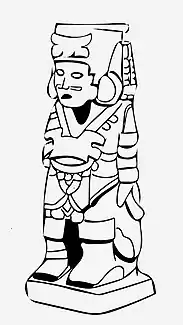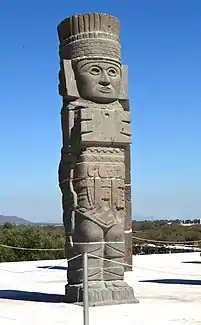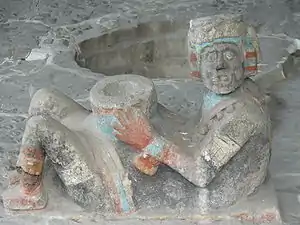Atlantean figures
Atlantean figures are carved stone support columns or pillars in the shape of fierce men in Pre-Columbian Mesoamerica. These figures are considered to be "massive statues of Toltec warriors".[1] They take their name from the European tradition of similar Atlas or Atalante figures in classical architecture, which was then revived in the Renaissance and especially popular in Baroque architecture. Atlantean here refers to the figures' supporting posture,[2] alluding to the load-bearing Titan Atlas,[3] not Atlantis.
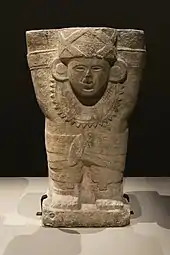
Though the most famous Atlantean figures reside in Tula, the Olmecs were the first to use Atlantean figures on a relief discovered in Potrero Nuevo.[4] Mayan sculptors also created Atlantean figures in Chichen Itza. Furthermore, the Aztecs, who greatly admired the Toltecs, created warrior statues strongly inspired by the Atlantean figures in Tula.[5]
Composition
Atlantean figures were made out of the available stone in the area they were created. Atlantean figures have been made using limestone, sandstone, and volcanic rock. They were carved by hand, presumably by multiple individuals at once. To carve them, sculptors would have used stone tools, such as small chisels for fine sculpting, scrapers of various sizes to shape and add little details, and stone hammers to break the stones. Additional smaller and softer stones were used for smoothing. Creating these figures would have been very time-consuming, which is an indication that they were important to the civilizations who created them.
Earliest example of Atlantes in Mesoamerica
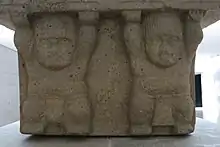
At Potrero Nuevo near San Lorenzo, part of San Lorenzo Tenochtitlán, there is an altar supported by two Atlantean figures. The Olmecs created this altar. At the moment, it is believed to be the "oldest Mesoamerican example of the themes of atlantes holding up altars or ceilings"[4] The atlantes at this site are also unique compared to those found at other sites. The atlantes are not carved in the round like they are at later sites. Instead they are carved as a relief.
Toltec Atlantean figures from Tula

Tula has long been considered the capital for the Toltec people. At Tula one can find the Temple of Tlahuizcalpantecuhtli ('House of the Morning Star'), where there are four Atlantean figures standing over 4.6 metres (15 ft) tall. The figures here are depicted as wearing "stylized butterfly breastplates, sun-shaped shields on their backs, feathered headdresses and carry spear throwers and a supply of spears".[6]
Dating
The exact dates for when Atlantean figures in Tula were carved is unknown. However, rough estimates can be made by dating the sites. The construction of the Toltec empire has been dated to approximately A.D. 750. [7] This dates mark the earliest time that the figures could have been carved.
Other sites
Mayan Atlantean figures from Chichen Itza
.jpg.webp)
Built by the Maya people, Chichen Itza is a site located on the northern centre of the Yucatan Peninsula and contains what is known as the Temple of Warriors. At the top of the temple, used as support for the roof, run columns of the carved warriors, each wearing a feathered headdress, a butterfly-shaped pectoral, and holding a dart thrower and darts.[1] Like the Atlantean figures in Tula, the figures from Chichen Itza cannot be dated exactly. The construction of Chichen Itza took place around A.D. 100-250, which is the earliest that the figures could have been carved.[7]
Aztec Atlantean figures from Tenochtitlan
Inspired by the Atlantean sculptures at Tula, Aztec sculptors built warrior sculptures with great resemblance to those created by the Toltecs. The Aztecs created some of these warrior statues in a group of five that resided in the Aztec capital. This group contained four male statues and one female statue. One bearded male warrior originally stood in the center of the group, while one male soldier stood North, East and South. The fifth sculpture, a female warrior, stood West. These warriors marked the center and four directions of the universe, and were meant to guard the sun.[5]
The Aztec Atlantean figures have the characteristics denoting a warrior. They hold spears and have clay nose bars, both indicators of military prowess. Like a Tula Atlantean figure, the typical Aztec Atlantean figure has a butterfly symbol on his chest. However, the typical Atlantean Aztec figure also has the symbol on his head. [5] Aztec Atlantean figures are currently displayed at the National Museum of Anthropology in Mexico City.[8]
Toltec influence
Tula, the ancient Toltec capital, collapsed in the 12th century, before the Aztecs established their city-states.[8] The Aztec people originally migrated from Aztlan across the central highlands before they reached the valley of Mexico, where they established Tenochtitlan. During their migration, they passed through the ruins of Tula.
The Aztecs regarded their predecessors, the Toltecs, as great warriors. The Toltecs defeated nearby peoples who they forced to pay tribute to Tula.[9] The Aztecs imitated the Toltecs, forcing tribute-towns to pay maize and other goods to Tenochtitlan.[10] Toltecayotl, which translates in Nahuatl to "to have a Toltec heart", was a term that indicated greatness, displaying the Aztecs' reverence of the Toltecs. According to Richard Townsend,
"[Toltecayotl] was to excel, to be worthy, to possess extraordinary qualities in the manner of the ancients."[11]
Therefore, by imitating Toltec Atlantean figures, the Aztecs associated themselves with the fearless warriors of an ancient nation regarded as great and powerful.[12] The Atlantean figures of Tenochtitlan were not the only sculptures that showed resemblance to the sculpture of Tula. Aztec standard-bearer statues, seating figures with flagpoles, are very similar to those found in Tula. Furthermore, the Aztecs created chacmools, reclining figures used for rituals, based on those that they encountered in Tula.[8]
Continuity or disjunction?
As Richard Townsend states, "the Aztecs drew on ancient artistic themes to associate themselves with the great traditions of Mesoamerican antiquary."[13] In "State and Cosmos in the Art of Tenochtitlan", Townsend explores whether Aztec sculpture maintains continuity with or diverges from sculpture of the past. Townsend states:
"The Mexica formed an art that would help to integrate their realm ideologically, and that would simultaneously serve to affirm the Mexica as legitimate successors to the great nations of the past." [12]
Townsend explores the dichotomy between continuity and disjunction by comparing Aztec warrior figures to Toltec Atlantean figures. He argues the some Aztecs figures possess characteristics especially similar to those of the Atlanteans from Tula. For example, he identifies one figure whose body is more contained within a planar, monolithic space.[8] The expression is less defined and the carved lines are less vivid. According to Townsend, this figure displays continuity. Townsend then observes another Aztec Atlantean figure that to him represents disjunction. The figure shows influence of more common Mexica style. Townsend points out greater detail, bold lines, deeper relief, and swelling of the face.[8] By looking closely at specific Aztec Atlantean figures, Townsend proves that the Aztecs imitated Toltec Atlantean figures but also integrated their own style and traditions.
Significance
Political
There is indication that Atlantean figures "express the rise of new kind of military order and associated types of behaviour ".[14] Between A.D. 850 and A.D. 900, archaeological evidence in the form of an increased number of emblems found throughout Mesoamerica support the idea that there was a "shift in leadership from the traditional one of paramount lord supported by lesser nobles (reflected in the radial stable networks and outlying elite complexes) to one that recast these supporting groups in the form of military orders".[15] Mesoamerican Atlantean figures are seen to be the representation of this shift in political thinking.
Religious
Many researchers believe that the figures at Tula may represent the Toltec ruler Ce Acatl Quetzalcoatl. Ce Acatl Quetzalcoatl is believed to be "named after the fair-skinned god worshipped by many Mesoamerica cultures".[6] It is possible, therefore, that Atlantean figures in Mesoamerica also share not just political roots, but religious roots as well.
Contemporary uses
Miniature Atlantean figures are now a common souvenir item for visitors to Mesoamerican sites.[16]
See also
References
- Evans, Susan (2008). Ancient Mexico and Central America: Archaeology and Culture History. London: Thames & Hudson Ltd. p. 42.
- Adams, Richard E. W. (2005). Prehistoric Mesoamerica. U. of Oklahoma Press. p. 302. ISBN 978-0-8061-3702-5.
These are the famous Atlantean figures, so named from their posture of burden-bearing.
- "Atlantean". Oxford English Dictionary (Online ed.). Oxford University Press. (Subscription or participating institution membership required.) "Pertaining to, or having the supporting strength of, Atlas."
- Bernal, Ignacio (1969). The Olmec World. California: University of California Press. pp. 58.
- Aguilar-Moreno, Manuel (2006). Handbook to Life in the Aztec world. Oxford: Oxford University Press. pp. 202. ISBN 978-0816056736. OCLC 58468201.
- "Tula". Ancient-Wisdom. Retrieved 2 October 2011.
- "Chichen Itza". Sacred Sites. Retrieved 29 September 2011.
- Townsend, Richard Fraser (1979). "State and Cosmos in the Art of Tenochtitlan". Studies in Pre-Columbian Art and Archaeology (20): 16. JSTOR 41263442.
- Townsend, Richard (2009). The Aztecs (3rd ed.). London: Thames & Hudson. p. 49. ISBN 9780500287910. OCLC 286447216.
- Townsend, Richard (2009). The Aztecs (3rd ed.). London: Thames & Hudson. p. 216. ISBN 9780500287910. OCLC 286447216.
- Townsend, Richard (2009). The Aztecs (3rd ed.). London: Thames & Hudson. p. 44. ISBN 9780500287910. OCLC 286447216.
- Townsend, Richard Fraser (1979). "State and Cosmos in the Art of Tenochtitlan". Studies in Pre-Columbian Art and Archaeology (20): 15. JSTOR 41263442.
- Townsend, Richard (2009). The Aztecs (3rd ed.). London: Thames & Hudson. p. 46. ISBN 9780500287910. OCLC 286447216.
- Fash, William (2009). The Art of Urbanism: How Mesoamerican Kingdoms Represented Themselves in Architecture and Imagery. USA: Dumbarton Oak Publishing. p. 371.
- Fash, William (2009). The Art of Urbanism: How Mesoamerican Kingdoms Represented Themselves in Architecture and Imagery. USA: Dumbarton Oak Publishing. p. 374.
- "atlantean figures - Google Search". www.google.com. Retrieved 2018-11-12.

